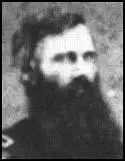Thomas Harris

Thomas Harris was born in Virginia in 1817. A doctor before the American Civil War, he joined the Union Army and soon reached the rank of lieutenant colonel. He was appointed commander of the 3rd Independent Division, Virginia in March, 1864. He was promoted to the rank of major general after taking part in the Petersburg assault.
When Abraham Lincoln was assassinated in April, 1865, Holt joined Edwin M. Stanton, Secretary of War and James Speed, the Attorney General, in calling for the conspirators to be tried by the military commission. The new president, Andrew Johnson, agreed and ordered the formation of a nine-man military commission. This included Harris, David Hunter, Robert Foster, August Kautz,, Lewis Wallace and Albion Howe. The Attorney General, James Speed, selected Joseph Holt and John Bingham as the government's chief prosecutors.
Mary Surratt, Lewis Paine, George Atzerodt, David Herold, Samuel Mudd, Michael O'Laughlin, Edman Spangler and Samuel Arnold were all charged with conspiring to murder Lincoln. During the trial the chief prosecutor, Joseph Holt, attempted to persuade the military commission that Jefferson Davis and the Confederate government had been involved in conspiracy.
Holt attempted to obscure the fact that there were two plots: the first to kidnap and the second to assassinate. It was important for the prosecution not to reveal the existence of a diary taken from the body of John Wilkes Booth. The diary made it clear that the assassination plan dated from 14th April. The defence surprisingly did not call for Booth's diary to be produced in court.
On 29th June, 1865 Mary Surratt, Lewis Paine, George Atzerodt, David Herold, Samuel Mudd, Michael O'Laughlin, Edman Spangler and Samuel Arnold were found guilty of being involved in the conspiracy to murder Abraham Lincoln. Surratt, Paine, Atzerodt and Herold were hanged at Washington Penitentiary on 7th July, 1865.
Primary Sources
(1) General Thomas Harris, letter to the The New York Sun (4th August, 1901)
It must be remembered that on the night of 17th April (1865) Payne returned to her house, with pick-axe on the shoulder and cap made from his shirt sleeve on his head.
The very act of this red-handed murderer fleeing to her home at such a time, was in itself, the strongest and most damning evidence against her.
Take away these two items of evidence - the terrible story of the shooting irons and Payne's return, wipe them out, remove them for the record, and Mr. Weichmann's evidence as to what he saw and heard in Mrs. Surratt's house falls harmlessly to the ground.
